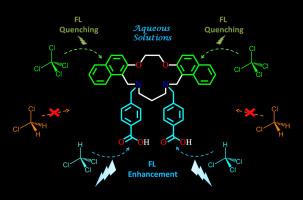一种新型二氮二氮冠大环发光化学传感器,用于选择性和灵敏地双重检测水中的氯化物
IF 4.7
3区 化学
Q2 CHEMISTRY, PHYSICAL
Journal of Photochemistry and Photobiology A-chemistry
Pub Date : 2025-08-30
DOI:10.1016/j.jphotochem.2025.116731
引用次数: 0
摘要
本研究设计、合成和表征了一种基于双酚二氮冠大环(L)的新型发光化学传感器,用于选择性和敏感地双重检测水中的氯甲烷和氯甲烷。L通过监测两种不同激发波长(293和370 nm)下荧光(FL)强度的变化,从而同时检测CHCl3(通过FL增强)和CCl4(通过FL猝灭)。计算出的CHCl3和CCl4的检出限分别为2.25和6.35 ppm,与几种传统方法相比具有较高的灵敏度。理论研究(DFT和TD-DFT)证实了其相互作用机理,其中CCl4通过C−Cl···π与萘部分相互作用形成基态配合物,导致静态FL猝灭,CHCl3通过C−H···O氢键与羧酸基相互作用,导致FL强度增加70%。该化学传感器的主要优点包括化学稳定性,可回收性(4次循环后回收率达90%),以及在水环境中的性能,使其成为监测水资源中氯化污染物的有前途的工具。本文章由计算机程序翻译,如有差异,请以英文原文为准。

A novel dinaphthodiaza-crown macrocycle-based luminescent chemosensor for selective and sensitive dual detection of CHCl3 and CCl4 in water
This study presents the design, synthesis, and characterization of a novel luminescent chemosensor based on a dinaphthodiaza-crown macrocycle (L) for the selective and sensitive dual detection of CHCl3 and CCl4 in water. L operates by monitoring fluorescence (FL) intensity changes at two distinct excitation wavelengths (293 and 370 nm), enabling simultaneous detection of CHCl3 (via FL enhancement) and CCl4 (via FL quenching). The detection limits for CHCl3 and CCl4 were calculated as 2.25 and 6.35 ppm, respectively, demonstrating high sensitivity compared to several conventional methods. Theoretical studies (DFT and TD-DFT) confirmed the interaction mechanisms, wherein CCl4 interacts with the naphthalene moiety via C−Cl···π interactions to form a ground-state complex, leading to the observed static FL quenching, and CHCl3 interaction with the carboxylate group via C−H···O hydrogen bonding, resulted in a 70 % increase in the FL intensity. Key advantages of this chemosensor include chemical stability, recyclability (with 90 % recovery after 4 cycles), and performance in aqueous environments, making it a promising tool for monitoring the chlorinated pollutants in water resources.
求助全文
通过发布文献求助,成功后即可免费获取论文全文。
去求助
来源期刊
CiteScore
7.90
自引率
7.00%
发文量
580
审稿时长
48 days
期刊介绍:
JPPA publishes the results of fundamental studies on all aspects of chemical phenomena induced by interactions between light and molecules/matter of all kinds.
All systems capable of being described at the molecular or integrated multimolecular level are appropriate for the journal. This includes all molecular chemical species as well as biomolecular, supramolecular, polymer and other macromolecular systems, as well as solid state photochemistry. In addition, the journal publishes studies of semiconductor and other photoactive organic and inorganic materials, photocatalysis (organic, inorganic, supramolecular and superconductor).
The scope includes condensed and gas phase photochemistry, as well as synchrotron radiation chemistry. A broad range of processes and techniques in photochemistry are covered such as light induced energy, electron and proton transfer; nonlinear photochemical behavior; mechanistic investigation of photochemical reactions and identification of the products of photochemical reactions; quantum yield determinations and measurements of rate constants for primary and secondary photochemical processes; steady-state and time-resolved emission, ultrafast spectroscopic methods, single molecule spectroscopy, time resolved X-ray diffraction, luminescence microscopy, and scattering spectroscopy applied to photochemistry. Papers in emerging and applied areas such as luminescent sensors, electroluminescence, solar energy conversion, atmospheric photochemistry, environmental remediation, and related photocatalytic chemistry are also welcome.

 求助内容:
求助内容: 应助结果提醒方式:
应助结果提醒方式:


